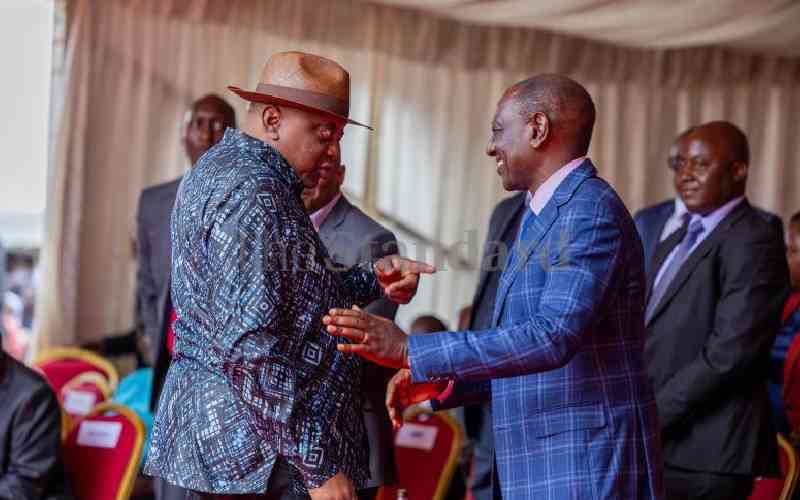The decision by the Government to hold on to billions of shillings in tax refunds belonging to the business community has been blamed for the ongoing cash-crisis.
In a special review on the state of the economy in developing countries, the International Monetary Fund (IMF) singled out Kenya’s defective tax system as a major impediment to business growth.
An increasingly difficult operating environment has seen a number of companies shed jobs in droves.
Several surveys, including one conducted by the Central Bank of Kenya, show that optimism among investors has declined.
The large accumulation of Value Added Tax (VAT) refunds, which arises when credit for taxes on inputs exceed tax due on sales, is one way that has had a negative bearing on cash flow to businesses, and by extension, to Kenyans' pockets.
A broad-based tax levied at multiple stages of production, VAT is in most cases levied on both inputs and outputs in the production chain. In Kenya, VAT is charged at the rate of 16 per cent on the final product.
According to the IMF, mechanisms employed by Kenya, Zambia, and Zimbabwe to respond to the challenge of large accumulation of VAT refunds has only made matters worse.
These countries, said the IMF, have mostly established special tax treatments for particular taxpayer groups. This, explained the global lender, has further complicated administration of VAT.
Other mechanisms that have been adopted to tackle the problem of large accumulation of refunds have involved the buyer withholding part of the VAT that is payable by a supplier, in what is known as Withholding VAT.
Reverse charge
There has also been the imposition of a “reverse charge,” to ensure that VAT due is paid to the government.
The result for these countries, explained the IMF, has been taxpayers paying more than they receive, thus amplifying the problem it was intended to address.
In a paper that examined the challenges faced by its 59 low-income developing countries, the IMF acknowledges that generally, managing refunds has been a thorny issue for tax administrators all over the world.
In Kenya, the Kenya Revenue Authority (KRA) has been under pressure to pay tax refunds running into billions of shillings. In a recent joint communique with the Kenya Alliance of Private Enterprises (KEPSA), KRA said it has paid Sh20.4 billion in tax refunds between July 2018 and October this year.
The taxman also established a team to facilitate the clearance of 6,000 VAT refund cases worth Sh27.6 billion outstanding as at the end of October.
Stay informed. Subscribe to our newsletter
In his budget speech, suspended National Treasury Cabinet Secretary Henry Rotich acknowledged that the accumulation of VAT refunds at the KRA due to VAT on zero-rated supplies has impacted negatively on the cash flow and liquidity for manufacturers and the business community at large.
“In order to fast track the return of these funds to the rightful owners, I have constituted a team at the National Treasury to quickly validate the outstanding refunds with a view to clearing them within the next two months,” said Rotich.
But huge refunds have also been a subject of a rigorous audit by the taxman owing to fears that some of these refunds have been fraudulently incurred.
KRA has, for example, unearthed a tax cheat syndicate in which 2,700 companies claimed 16 per cent VAT and 30 per cent relief on corporation tax. Known as the missing trader scheme, the syndicate would have seen the country lose close to Sh10 billion from VAT.
Guarding against fraud
The IMF notes that in an attempt to guard against such frauds, most low-income countries subject all refund claims to audit, even for taxpayers who regularly apply for refunds such as exporters, and without applying any risk profiling.
“As a result, the processing time for refunds can be months or even years,” states IMF.
The Government plans to reduce Withholding VAT from six per cent to two per cent to unlock funds held in VAT credits.
According to a new amendment to the Value-Added Act, 2103, taxpayers can also simply use the excess Withholding VAT to offset any other tax liability, including Pay As You Earn (PAYE), corporate tax, excise and customs duty
The IMF has recommended that Treasuries set aside part of VAT revenue to cover expected refunds.
 The Standard Group Plc is a
multi-media organization with investments in media platforms spanning newspaper
print operations, television, radio broadcasting, digital and online services. The
Standard Group is recognized as a leading multi-media house in Kenya with a key
influence in matters of national and international interest.
The Standard Group Plc is a
multi-media organization with investments in media platforms spanning newspaper
print operations, television, radio broadcasting, digital and online services. The
Standard Group is recognized as a leading multi-media house in Kenya with a key
influence in matters of national and international interest.
 The Standard Group Plc is a
multi-media organization with investments in media platforms spanning newspaper
print operations, television, radio broadcasting, digital and online services. The
Standard Group is recognized as a leading multi-media house in Kenya with a key
influence in matters of national and international interest.
The Standard Group Plc is a
multi-media organization with investments in media platforms spanning newspaper
print operations, television, radio broadcasting, digital and online services. The
Standard Group is recognized as a leading multi-media house in Kenya with a key
influence in matters of national and international interest.








